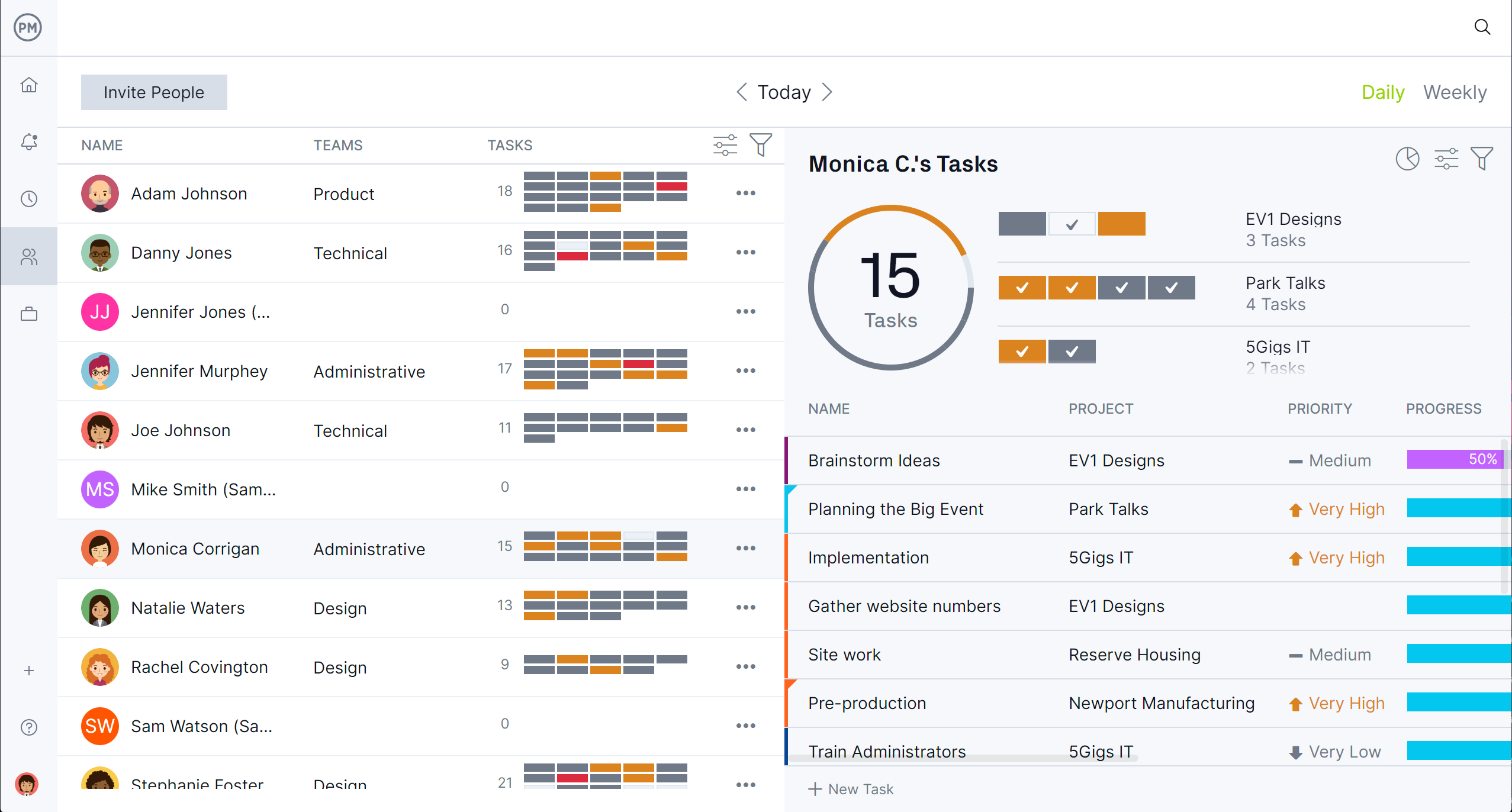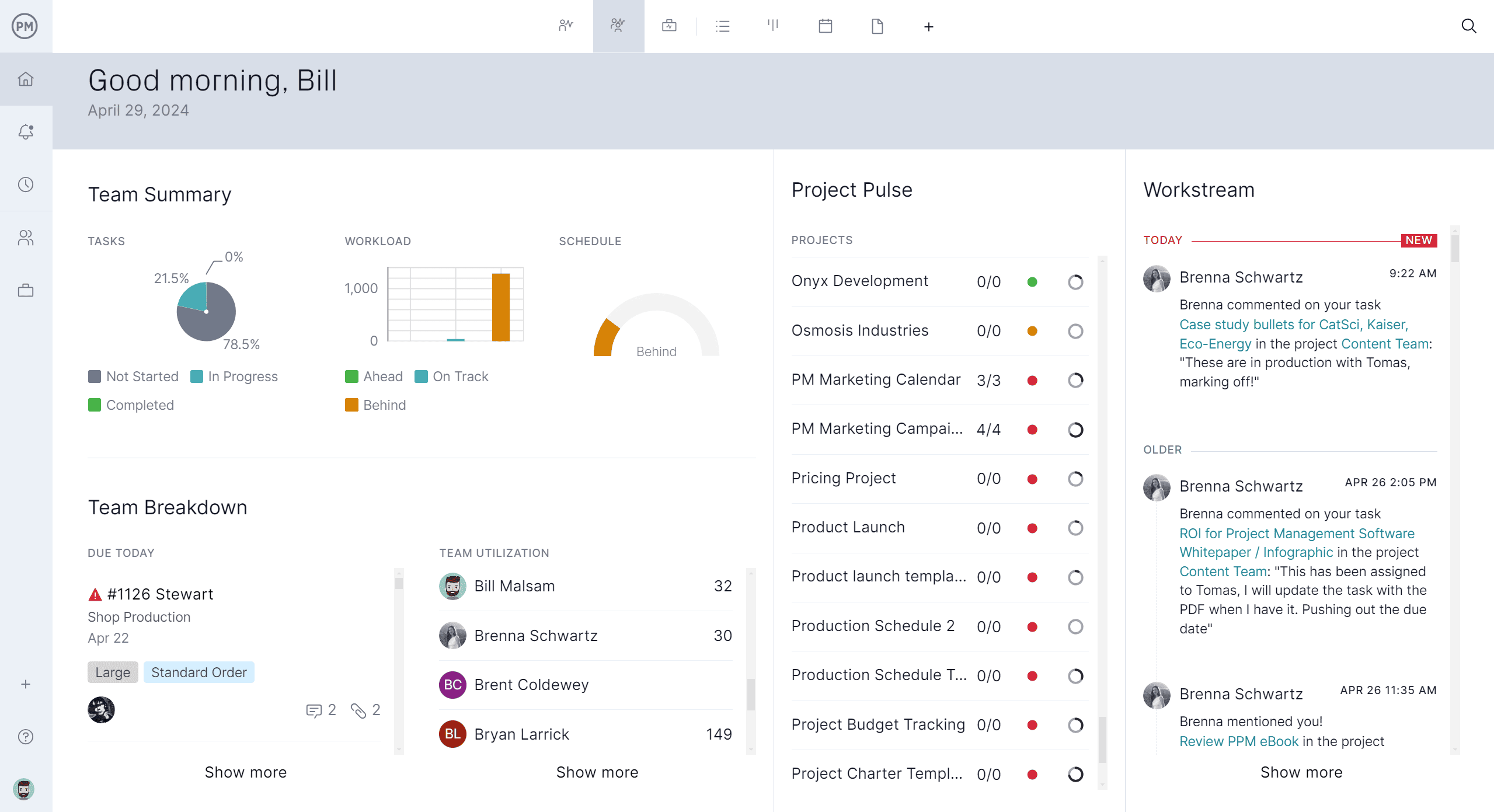Writing a work proposal is an essential step when outlining how a specific job, task or project will be approached and completed. A well-crafted work proposal helps communicate your understanding of the client’s or organization’s needs, the services you will provide, estimated costs and a timeline for delivery.
Whether you’re a freelancer pitching to a client, a contractor submitting to a firm or an internal team member seeking approval, a strong work proposal sets the stage for professional collaboration and project success. It should be clear, concise and tailored to the audience, with a focus on delivering value to persuade your audience.

Get your free
Work Proposal Template
Use this free Work Proposal Template to manage your projects better.
Get the Template
What Is a Work Proposal?
A work proposal is a formal document that outlines how a specific job, task or project will be executed. It typically includes key details such as the scope of work, objectives, deliverables, timeline, budget and responsibilities. Work proposals are commonly used in business, construction, creative services, consulting and many other industries to pitch a plan of action for clients, stakeholders or internal decision-makers. The document serves to clarify expectations, establish alignment and provide a roadmap for the work ahead.
A well-structured work proposal not only communicates the “what” and “why” of a project but also the “how”—laying out step-by-step activities, key milestones and dependencies. It often includes visual aids or references to other planning tools to support the proposed approach. The proposal becomes a foundation for contracts, task assignments and resource planning, making it a critical starting point in formalizing any project or engagement.
This is where the work proposal directly informs a Gantt chart. By defining tasks, deadlines and sequences in the proposal, project managers can easily transfer that information into a Gantt chart to visualize the project timeline. The detailed breakdown of work in the proposal becomes the chart’s structure, with tasks plotted over time, dependencies linked and milestones marked. This not only facilitates planning and resource allocation but also provides a dynamic way to monitor progress and adjust as needed throughout the project’s lifecycle.
Don’t trust your project proposal to just any Gantt chart. Most project management software includes this tool, but only ProjectManager has a Gantt chart that does more than schedule tasks, resources and costs. Our Gantt chart links all four types of task dependencies to avoid cost overruns and bottlenecks to deliver the work as proposed. It can quickly filter for the critical path to identify essential tasks and slack and better prioritize work. Then set a baseline to track progress in real time. Get started with ProjectManager today for free.
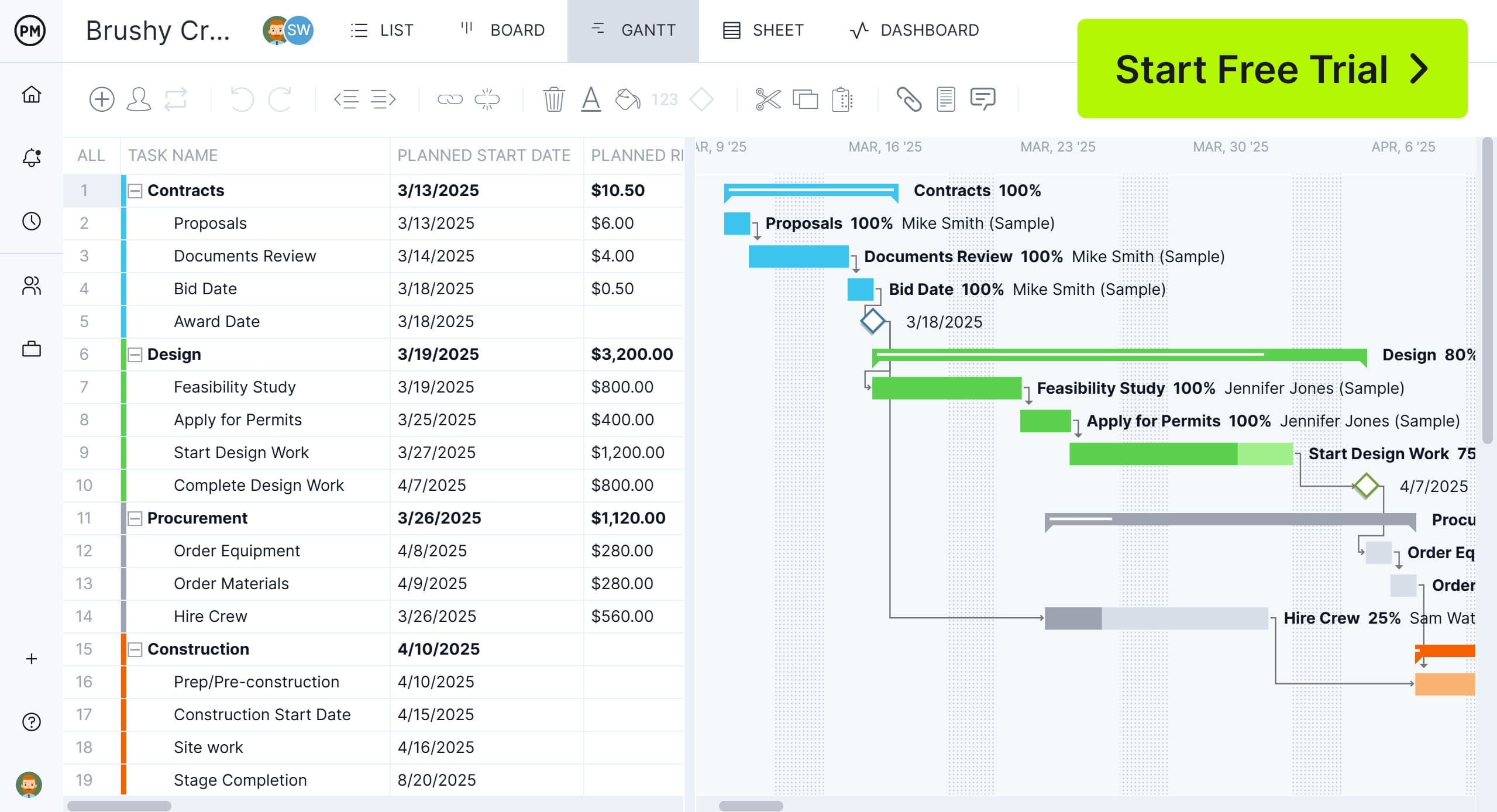
When to Make a Work Proposal?
A work proposal should be created any time you need to formally present a plan for completing a task, service or project—especially when approval, funding or collaboration is required. This applies to freelance projects, internal initiatives, client work, construction jobs, consulting engagements and more.
A well-timed work proposal helps align expectations, secure resources and outline deliverables before any work begins. It’s particularly useful when responding to a request for proposal (RFP), initiating new client relationships or pitching a structured approach to a new initiative.
How to Write a Work Proposal
A work proposal is a vital document that outlines how a task or project will be completed, including its goals, scope, timeline, cost and terms. Whether you’re responding to a client request, pitching a new internal initiative or formalizing a plan for stakeholders, a work proposal provides a clear, professional structure to communicate your approach. It sets expectations early and ensures that everyone involved understands the work to be done and how it will be executed. Follow these steps to write an effective work proposal.
1. Define Goals and Objectives
Begin by clearly stating the purpose of the work proposal. What problem does the work solve? What goals are you aiming to achieve? Be specific and tie objectives to measurable outcomes whenever possible. This section should set the tone and justify why the project is worth pursuing.
2. Describe the Scope of Work
Lay out exactly what the project entails, including tasks to be completed, services to be provided and any deliverables. This helps prevent scope creep and ensures all parties have a shared understanding of what is—and isn’t—included in the proposal.
3. Establish a Timeline
Provide a detailed schedule that breaks the project into phases or key milestones. Include start and end dates and estimated duration for major tasks. This timeline often serves as the foundation for a Gantt chart or other project management tool.
4. Estimate Costs
Break down the anticipated costs associated with the project. This might include labor, materials, travel, equipment and any other relevant expenses. Present the estimate clearly to support budgeting and approval processes.
5. Specify Terms and Conditions
Outline the legal or contractual terms that will govern the work, such as payment schedules, warranties, cancellation policies and intellectual property rights. This protects both parties and ensures a smoother working relationship.
Work Proposal Template
Download our free work proposal for Word to outline a plan for completing a specific project, task or service. It includes key information such as the objectives, scope of work, timeline, estimated costs, deliverables and more. Work proposals are commonly used in business settings—by contractors, consultants, freelancers and internal teams—to pitch ideas, respond to requests for work or seek approval for an initiative. The document helps clarify what will be done, how it will be done and the resources required, ensuring alignment between all parties involved.
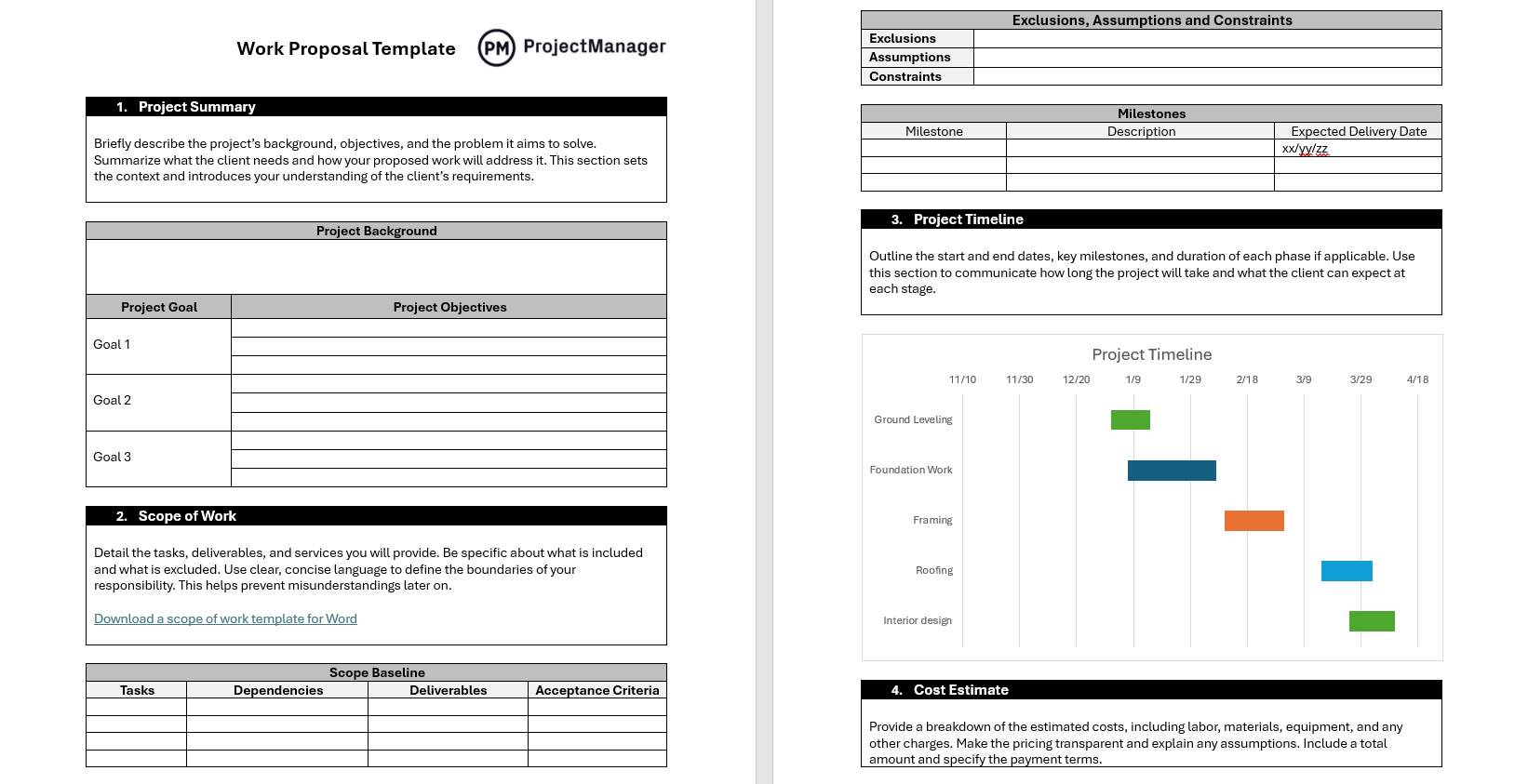
Beyond securing approval, a work proposal serves as a foundational planning tool. It provides a structured overview that can be referred to throughout the project’s lifecycle to guide execution and manage expectations. A well-written proposal can also minimize misunderstandings and reduce the risk of scope creep by clearly defining deliverables and responsibilities up front. Whether for internal stakeholders or external clients, a comprehensive work proposal sets the stage for successful collaboration and project delivery.
Work Proposal Example
Here’s a simple example tailored to a manufacturing project to help you better understand how to write a work proposal. This work proposal sample outlines how a company presents its plan to produce custom components for a client, including goals, scope, timeline, costs, and terms. Use this as a reference to structure your own proposal clearly and professionally. Whether you work in manufacturing or another industry, this work proposal example can guide you in communicating your plan effectively and securing client approval.
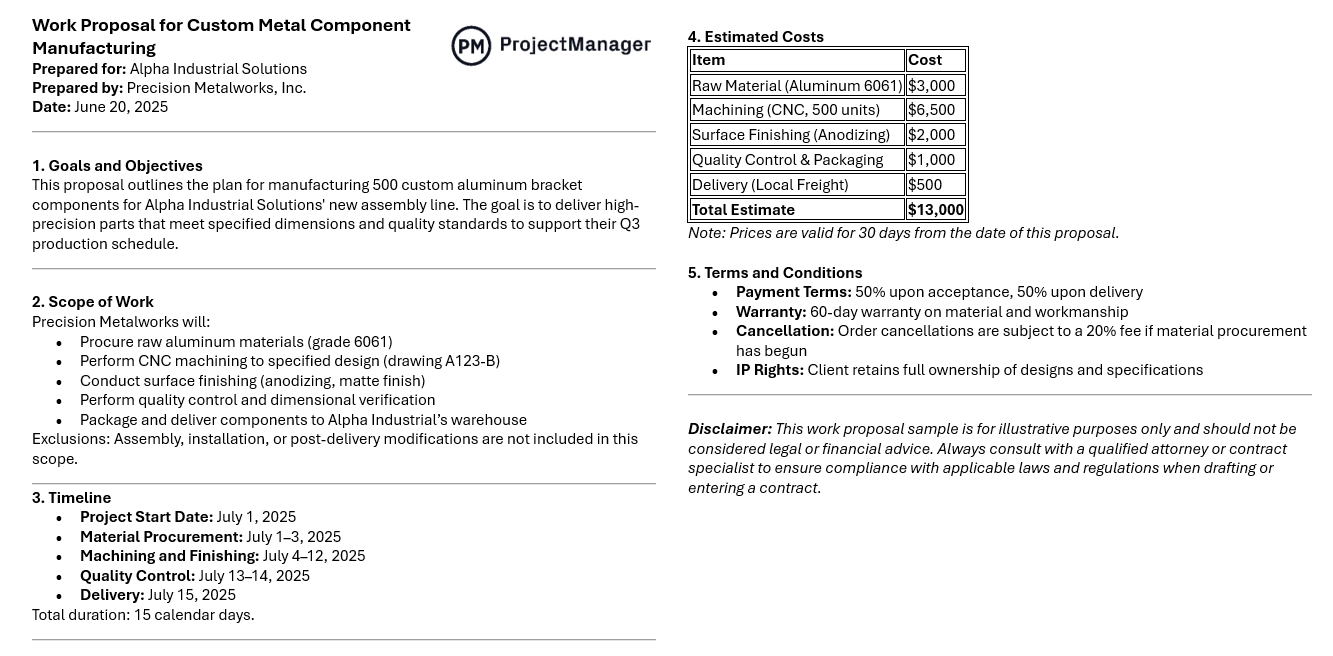
Related Work Management Templates
Work management is larger than a work proposal, though that’s an important starting point. Other free templates can also help get the job done right. Below are a few examples of those templates taken from the over 100 free project management templates for Excel and Word that are available for immediate download from our site.
Statement of Work Template
Download this free statement of work (SOW) template for Word to outline the essential details of a project agreement between two or more parties, such as a client and a contractor. It defines the scope of work, project objectives, deliverables, timelines, milestones, payment terms and responsibilities.
Work Order Template
Use this free work order template for Excel to outline the details of a service request, maintenance activity or job that needs to be performed. The template ensures all necessary information is collected consistently and completely for each work order, streamlining the process and minimizing errors.
Work Instruction Template
This free work instruction template for Word is used to outline how to perform a task or process step-by-step. It ensures consistency, quality, and safety by providing detailed, easy-to-follow directions for employees or operators.
How ProjectManager Helps With Work Management
Don’t trust your work management to static templates. ProjectManager offers a versatile suite of work management tools designed to accommodate different project styles and team preferences. Users can switch seamlessly between Gantt charts, kanban boards, sheets, list views and calendar views, allowing them to visualize and manage tasks in the way that best suits their workflow.
We already talked about the Gantt chart, but kanban boards facilitate agile task management with drag-and-drop functionality, while sheet view offers spreadsheet-like organization and task lists allow teams to manage their work. The calendar view helps teams or stakeholders track deadlines and milestones, ensuring everyone stays aligned on project timelines.
Help Teams Optimize Their Workforce Efficiently
When onboarding teams set their availability to allow project managers to see when team members are free or booked, preventing over-allocation and burnout. Color-coded workload charts visually represent each resource’s capacity, making it easy to balance assignments and identify bottlenecks. Additionally, the team page centralizes information about all project contributors, offering quick access to task priority, progress and current assignments, which streamlines communication and coordination.

Get Real-Time Insights Into Progress and Performance
Keep projects on track with interactive dashboards that display key metrics at a glance, enabling project managers to monitor project health and make informed decisions quickly. Customizable reports allow teams to generate detailed analyses tailored to specific needs, such as budget tracking, task completion or resource utilization, as well as sharing reports to keep stakeholders up to date.
Secure timesheets ensure accurate tracking of hours worked, facilitating transparent billing and payroll processes. Together, these features empower teams to maintain control over their projects from planning through execution and delivery.

Related Work Management Content
Learning how to write a work proposal can help get the project approved, but that’s only the start of work management. For those who want to read more on the subject, below are links to some recent articles we’ve posted on our blog about work orders, different work styles and more.
- What Is a Work Plan? How to Make a Work Plan In 7 Steps
- A Quick Guide to Work Orders: Example & Template Included
- How to Identify Different Work Styles for Better Productivity
- What Is Work Management? Creating a Work Management System
ProjectManager is online project and portfolio management software that connects teams whether they’re in the office or out in the field. They can share files, comment at the task level and stay updated with email and in-app notifications. Join teams at Avis, Nestle and Siemens who use our software to deliver successful projects. Get started with ProjectManager today for free.

